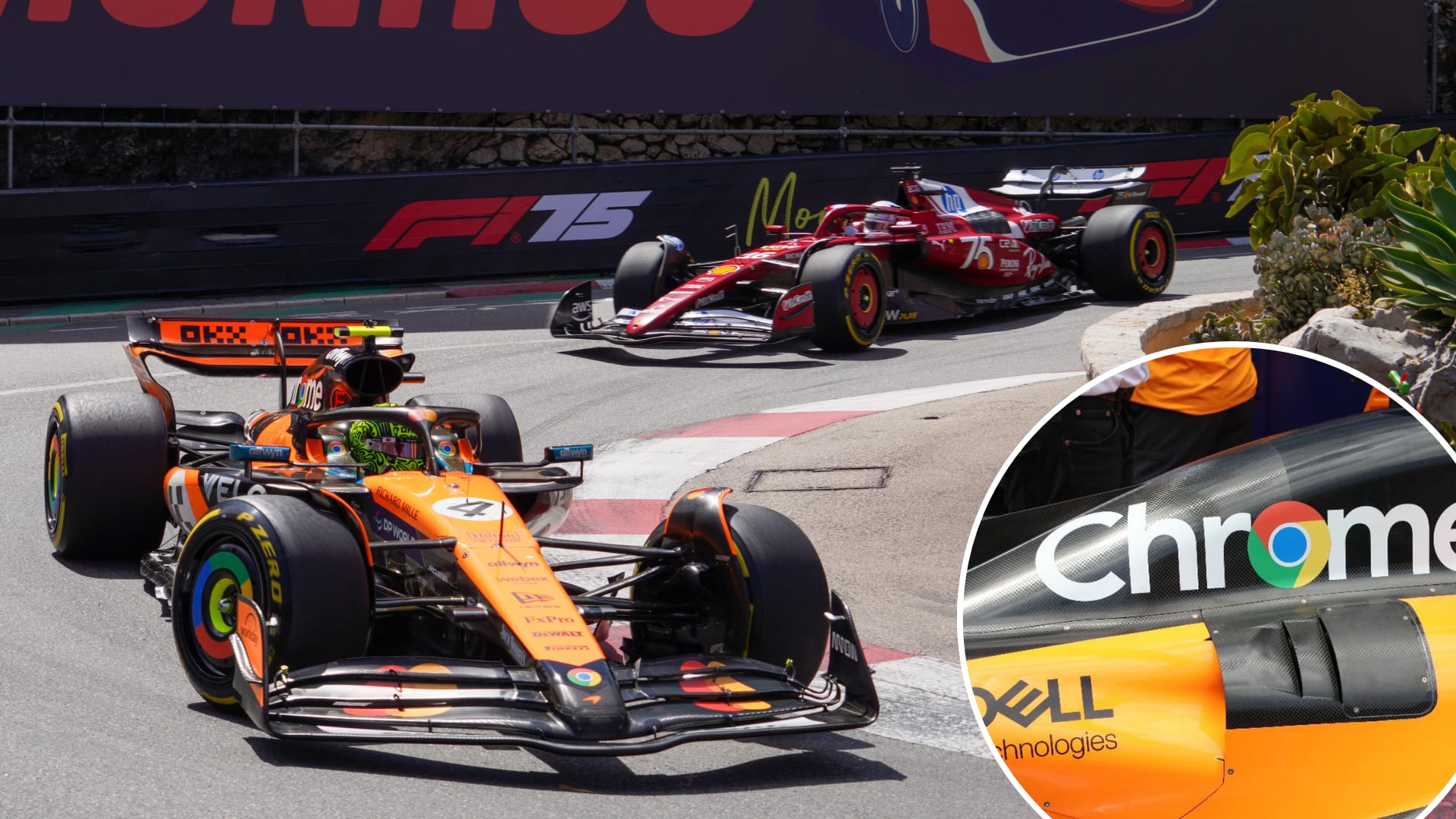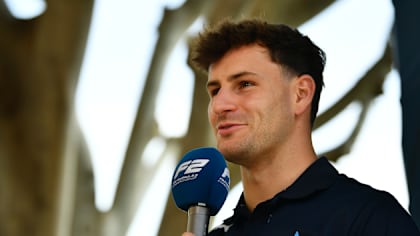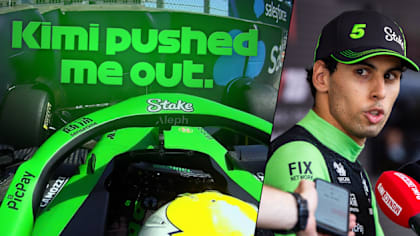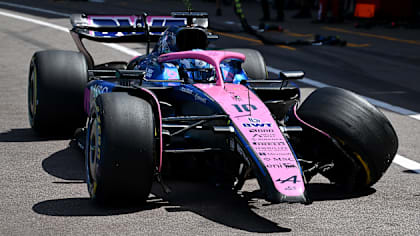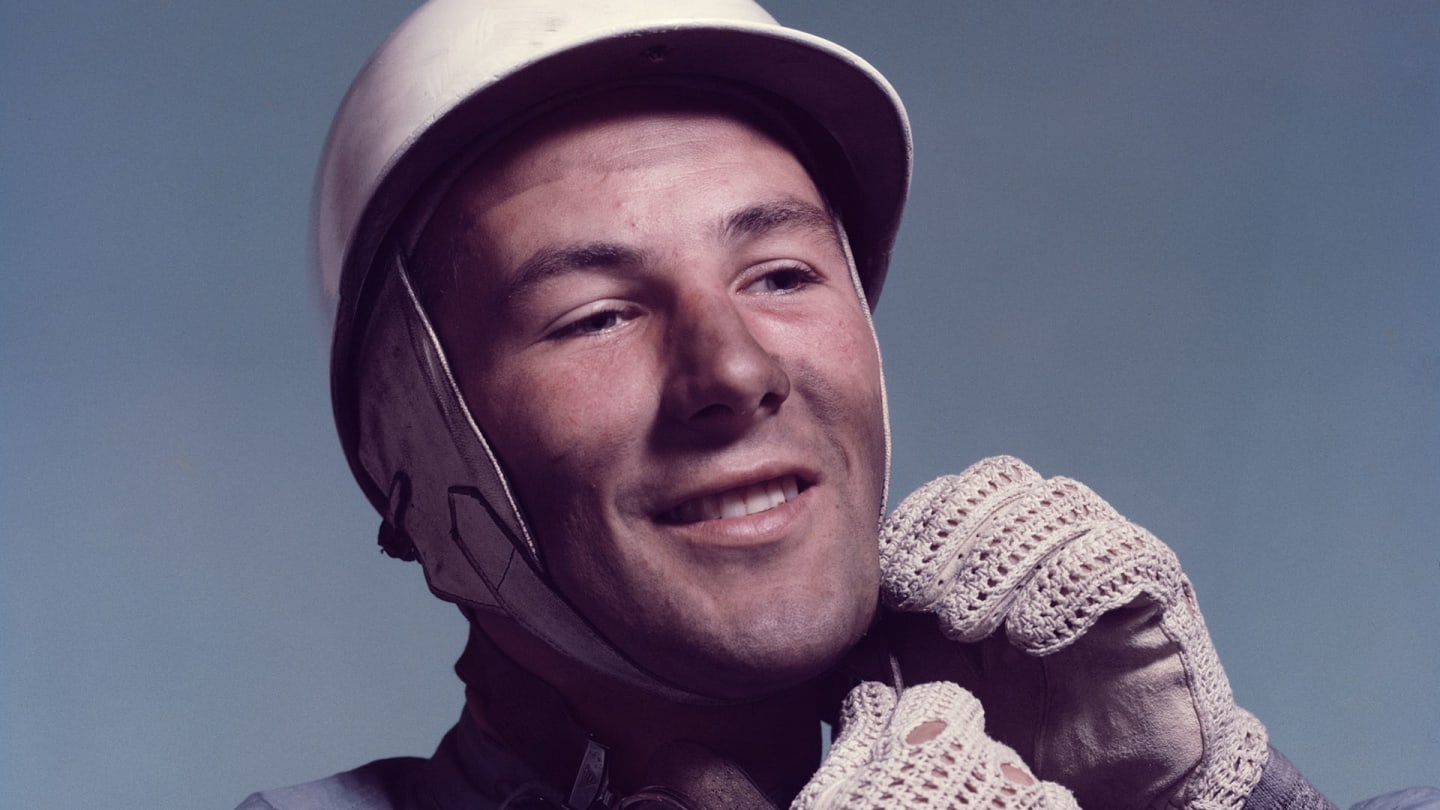
Feature
The king that was never crowned - Sir Stirling Moss remembered
Share

They used to call him the man who made the impossible possible. Yet somehow, the World Championship never surrendered to Stirling Moss.
It didn’t matter.
When, at Easter almost sixty years ago, his life hung in the balance after a heavy and still largely unexplained accident at in the Glover Trophy race at Goodwood, the whole of Britain waited with baited breath for news of his condition.
In his heyday he was the ultimate racer, and despite his failure to win the World Championship, his public adored him. He had become one of those rare icons who attained that highly unusual state of grace that falls to only a handful of men. He was Mr Motor Racing and retained the public affection and a popularity that for years afterwards prompted some police officers who stop speeding motorists to enquire with what passed for humour in such circles: 'Who do you think you are, Stirling Moss?'
Stirling Moss, Cooper-Climax T51, Grand Prix of Monaco, Monaco, May 10, 1959. (Photo by Bernard Cahier/Getty Images)
Stirling Craufurd Moss’s name became etched on the public psyche in Britain as indelibly as those of footballer Stanley Matthews and boxer Henry Cooper. He was still news, whatever he did, and for many years of his ‘retirement’ he showed absolutely no sign of slowing down.
Life continued at full throttle, and instead of a Maserati 250F, a Mercedes W196, a Vanwall, a Cooper or a Lotus being held in a delicate four-wheel drift, he would balance the demands of a hectic schedule of business activities with the same commitment that he brought to his racing. Whether it was historic racing and rallying, getting knocked off his scooter, failing his driving test, or advertising Viagra, he made the headlines. But you never read a bad word about him.
Ten years ago, aged 80, he had an appalling accident when the lift in his Mayfair home malfunctioned. He stepped into a void and fell three storeys. Back in 1960, after a serious crash at Spa left him with broken legs, back and nose, he had been back racing within seven weeks. But now he was half a century older and had broken his ankles. Yet he was back up on his feet literally within weeks. His fortitude was incredible.
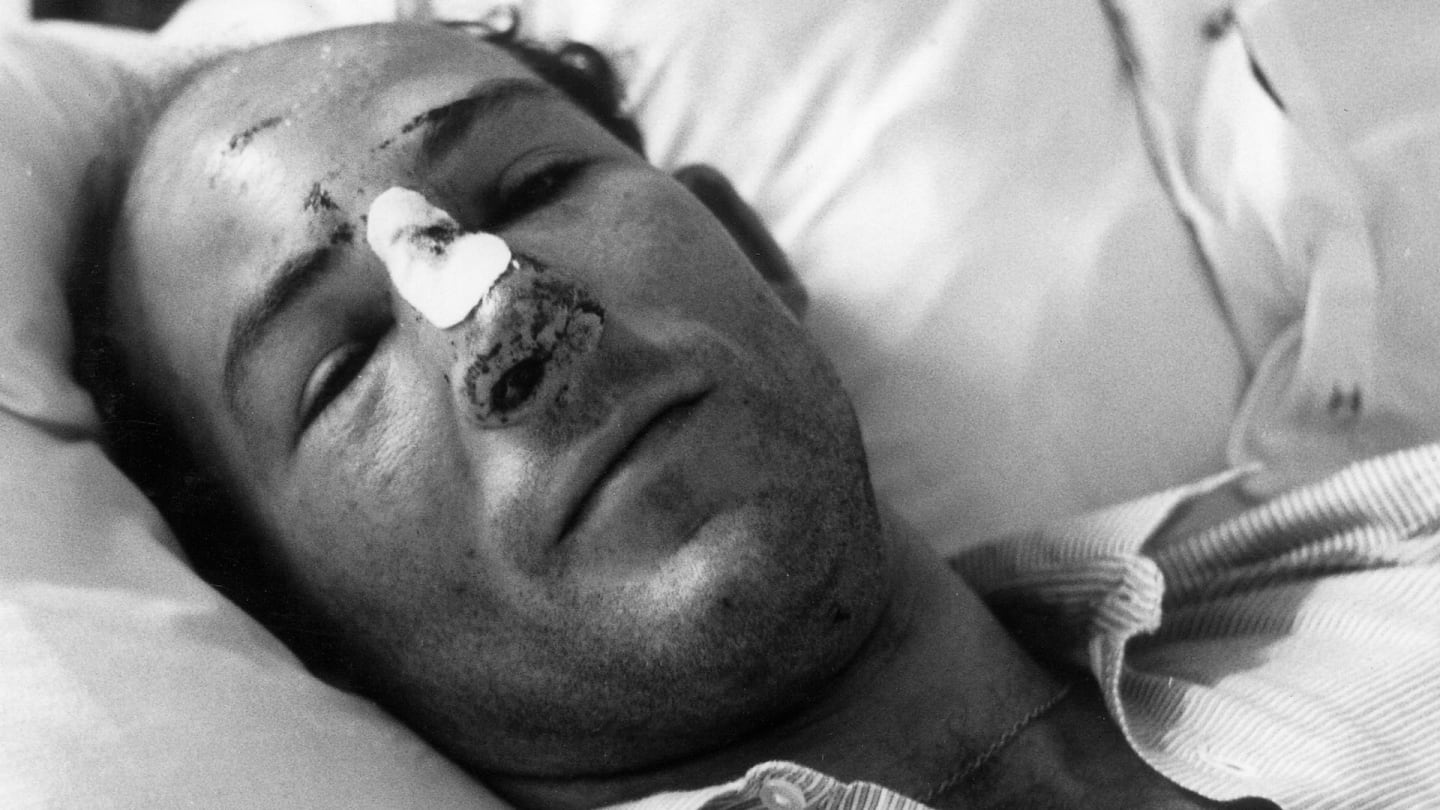
Moss showed incredible resilience to come back so quickly from injuries sustained in Belgium in 1960. (Photo by Bernard Cahier/Getty Images)
Of course, he cared about not winning the title. Deeply. At the time. When, each year from 1956, something silly happened to his cars and denied him, and he watched lesser drivers wearing his crown. He even, almost, denied himself once, because of the badge of honesty and chivalry that he wore like a medieval knight. It wasn’t just what you did that mattered to him, but the manner in which you did it.
No race better summarises his character than the 1958 Portuguese Grand Prix. That year he would win four times. Rival Mike Hawthorn won just once, yet pipped him to the title by a mere point. Ironically, had Stirling not stood up for his fellow countryman in Portugal, the title would have been his.
READ MORE: F1’s Best Drives – Moss withstands the might of Ferrari at the Nurburgring
Hawthorn's Ferrari Dino 246 was inferior to Moss' Vanwall on many points, but reliability wasn't one of them. It wasn't a tortoise and hare situation, though. By season end Hawthorn had 49 points from nine finishes, but that was corrected to 42 as drivers could only count their six best results. Stirling finished only six times, earning 41 points. He would never come closer to the crown.
But for all that, the season effectively turned on that one race in Portugal, when Hawthorn spun on the final tour as Moss was about to lap him. “He went up the escape road and then he got a push back. And later the stewards said that wasn't on…"
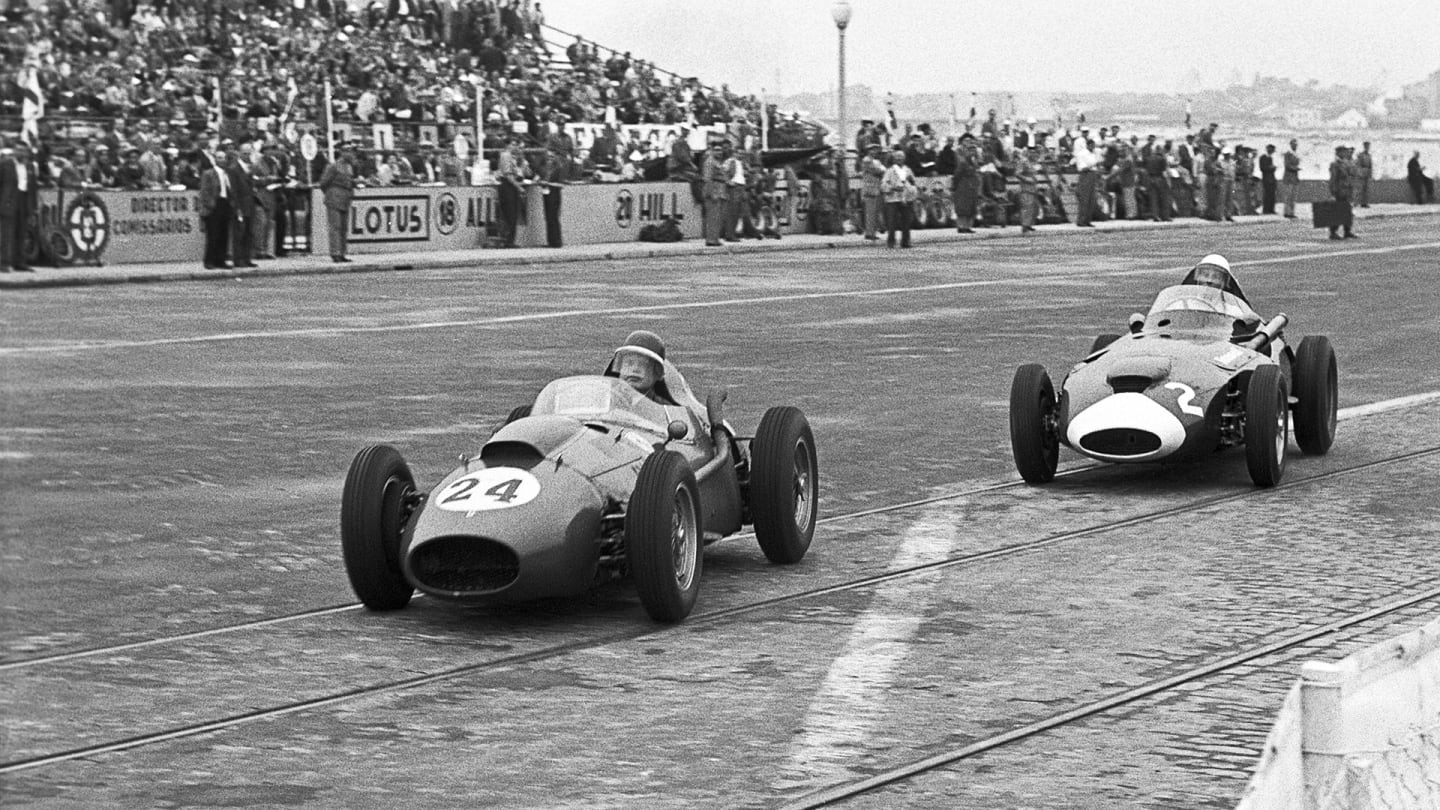
Moss, seen here tailing friend and rival Mike Hawthorn, was quicker than his fellow Brit throughout 1958 - but Moss's sportsmanship at the pictured race in Portugal handed the title to Hawthorn. (Photo by Bernard Cahier/Getty Images)
Actually, though Hawthorn pushed the car himself and didn't have assistance, he was facing exclusion after bump-starting his engine and letting the Ferrari briefly mount a footpath going in the opposite direction to the circuit, an area not designated as race track. The situation was getting unpleasant, when Moss voluntarily stepped forward in his defence. At the time nobody could know how crucial this incident was to be, but in any case he would have derived no pleasure from seeing his rival denied points on a technicality.
“To me, Mike shouldn't have been disqualified. I just felt that it was quite wrong that he should be disqualified. And I put forward the idea that he was still on the track, albeit the escape road, which they accepted. And it turned out that it lost me the title. But it's a case of what winning means to you."
His philosophy was that racing was what mattered. And he was a racer. Not for him settling for lesser placings.
At the end of 1958 he analysed his feelings and came to terms with the frustration of his greatest ambition. From then on his outlook began to mellow and the world title would never be quite so important to him.
“My attitude did change. Because I really believed that year that I ought to be the champion. I felt that I had the ability, and so on, and I didn't win. And it was against Mike Hawthorn, who was actually quite a good friend of mine. I really felt that I could beat Mike, and he of course beat me by a point.
“And then I thought, well, Mike drinks, and he runs around, and he does everything that I would like to do, and still I've been punished for not doing it. What the hell, I'm going to go out and enjoy myself."
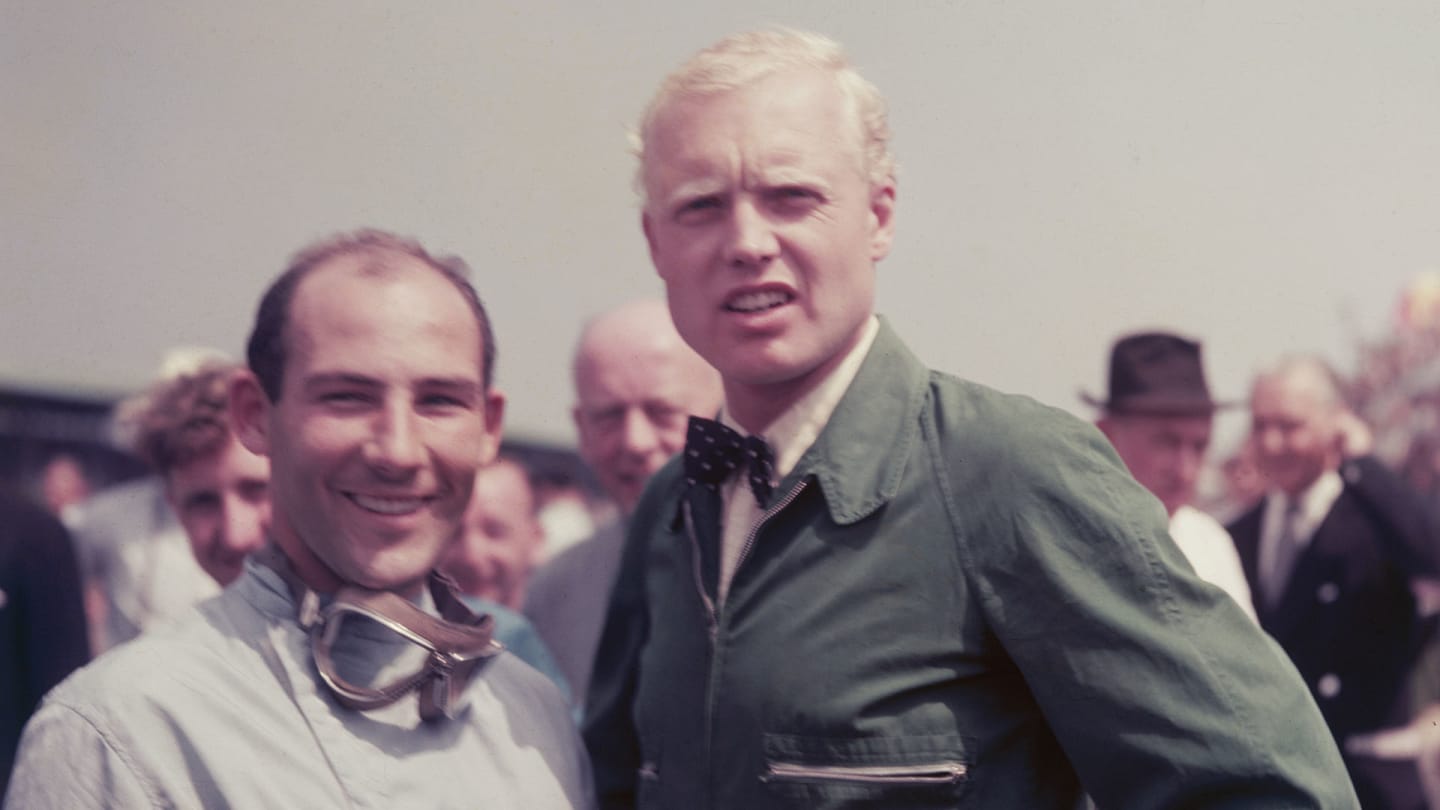
Friends and rivals, Moss (left) and Mike Hawthorn battled for the 1958 title - Hawthorn eventually getting the nod despite winning fewer races.. (Photo by Central Press/Hulton Archive/Getty Images)
His philosophy was always that he would rather lose a race driving fast enough to win, than win a race driving slow enough to lose. “I am a racer, I'm not a driver,” he stressed, with careful distinction. “And I think that is not an intelligent thing to be; one should be a driver and a racer as well, but I enjoy racing. I enjoy dicing with other guys. To me that's what it's about."
He once admitted that he did not spin a car for the first four years of his career, because he was scared of what might happen. And when, with huge reluctance as his career gathered momentum, he decided that he had to “go foreign,” and buy a Maserati 250F for grand prix racing, he kept his number in the phone book so that anyone who objected could call him to discuss it.
READ MORE: Argentina '58 - Moss bluffs his way to victory and ushers in new era
Could you imagine a single racing driver in the world who would do that today? For all the disappointments and mechanical breakdowns, his list of achievements was stellar.
He started 66 Grands Prix, 16 times from pole position, 37 times from the front row of the grid. He won 16 times, and should have won at least as many times again, and set fastest lap on 20 occasions. In the years from 1955 to 1958 he was second in the World Championship, from 1959 to 1961, third.
In sportscars he was frequently untouchable, and while he might not have been able to match the great Fangio, whom he revered, when they were F1 team-mates at Mercedes-Benz in 1955, he had the Argentine’s measure in the 300SLR sportscars.
That year he was instrumental in the marque winning the World Sportscar Championship, thanks to his brilliant victories on the Mille Miglia with Denis Jenkinson, and in the Targa Florio with Peter Collins. He also dominated the Tourist Trophy. When Moss was in a sportscar, the only time he was beaten was by unreliability.
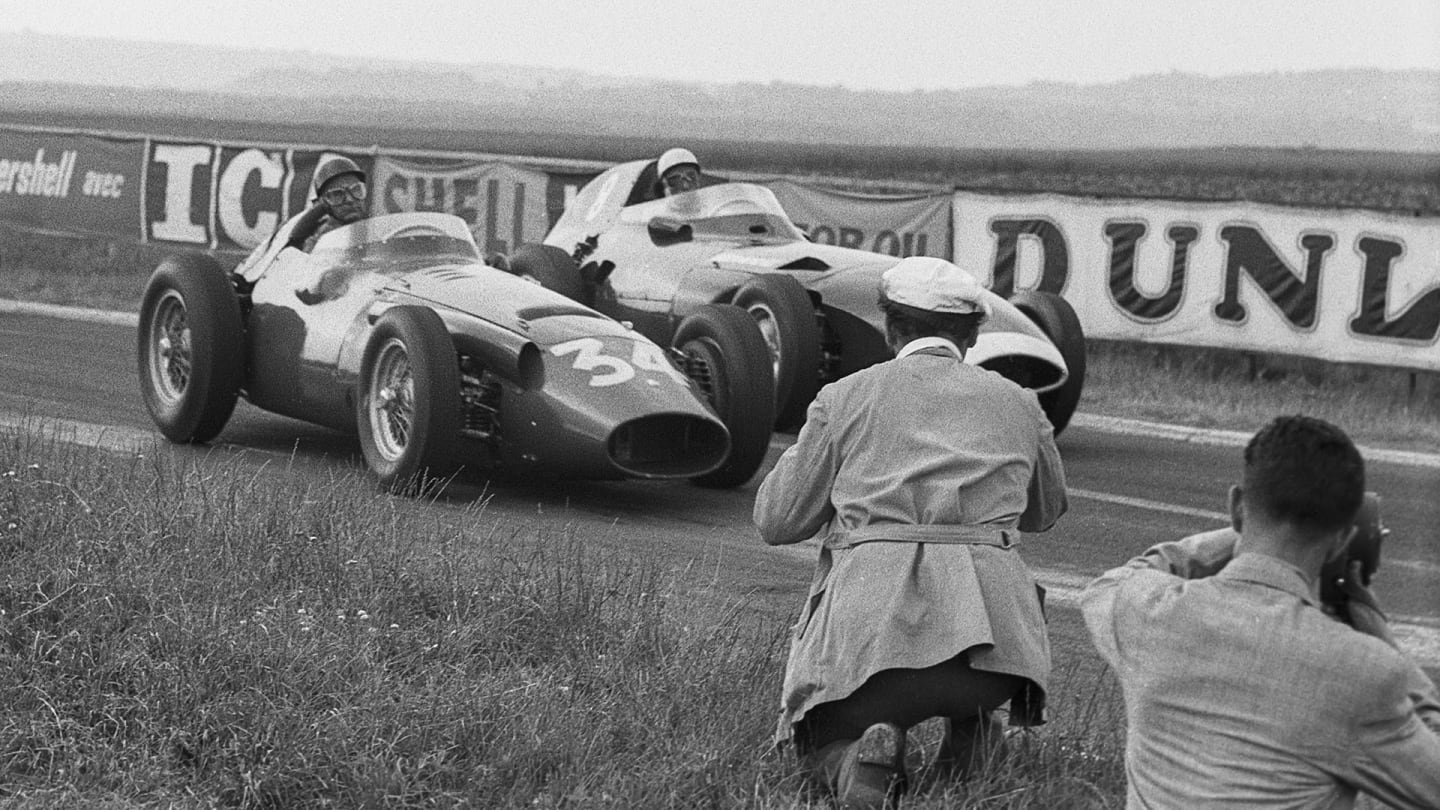
Moss liked nothing more than dicing with a rival. Here he goes wheel-to-wheel with former team mate Juan Manuel Fangio in France in 1958. (Photo by Bernard Cahier/Getty Images)
He was a superb touring car driver, and set straight-line records with a streamlined MG at Bonneville. Few others can lay claim to such all-round versatility.
Stirling often wondered what might have happened had he tried to come back a year later than he did, after the accident at Goodwood. The much-missed Professor Sid Watkins once made the interesting observation that he should have left himself more time, and Stirling himself was quick to take up the point when it arose.
But though the specialist press by and large steered clear of bulletins and prominent stories about his health at the time, while no doubt fretting off the page, the dailies had a field day which nonetheless revealed the depth of national feelings for the fallen hero. Everybody wanted Moss back - soon - as if his very return could somehow convince every man of the strength of human will as it triumphed over the odds. The Daily Express even had a photographer on regular standby at Goodwood in case he went testing in secret. There was tremendous, if benign, pressure upon him. As usual, however, the greatest pressure came from within.
“Now, in hindsight, I probably came back two years too early," he conceded. “It was stupid, but the reason I came back was because every week the press was saying, 'Are you going to race, are you going to drive?' I of course was telling myself, 'Yes, my God I'm going to, I want to.'"
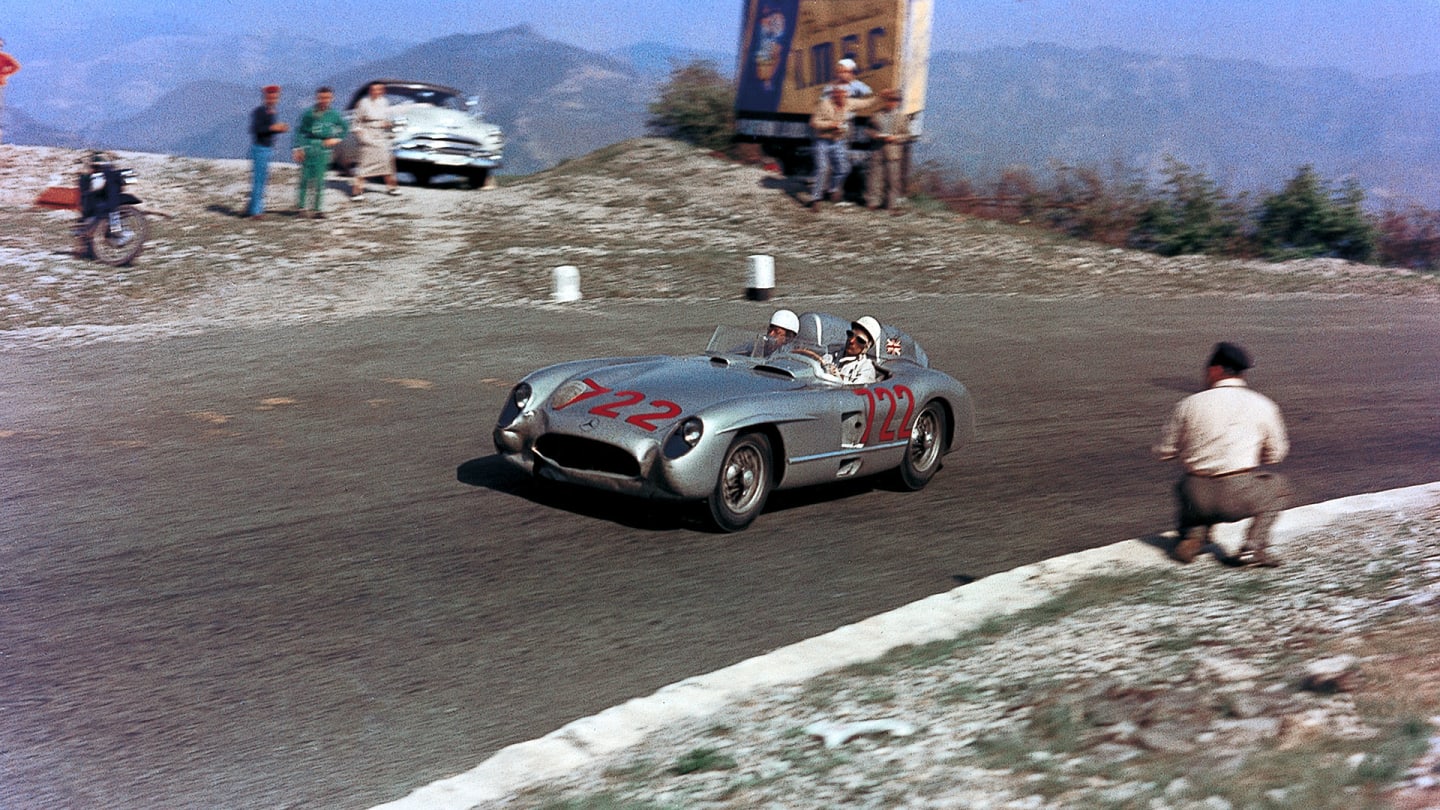
Moss's victory on the 1955 Mille Miglia has been hailed one of the all-time great drives in motorsport history. (Photo by Klemantaski Collection/Getty Images)
In the past his recovery from physical injury, such as that time at Spa, had stunned onlookers, but this was something of a different nature.
“Again, it's the thing about being there at that time. We didn't have people around like the Prof. They didn't exist. When one looks back and one sees the whole picture, it's very easy to say this and that. But at the time we didn't have people like old Watkins. If there had been people like that in the sport, I'm sure that I would have listened to them. But there was nobody to listen to, really, except myself. The doctors said physically I was okay, and I knew that, but the concentration wasn't there. And because the people that I was with were not racing people, it was very much a different situation.
WATCH: When Hamilton and Moss took two classic Mercedes race cars for a spin
“Because there were all of these articles and so on, I felt that I had to make a decision. There was the pressure on me to make one, really. In the nicest possible way. So I went down to Goodwood and my lap times were comparable with what I could do normally, but I could see mentally that I didn't have the concentration to do it with the same sort of latitude for safety that I had.
“The thing was that I was going into corners and I had to force myself to concentrate. Right, I'm going down the straight now, that's where you have to lift off... Everything was worked out, whereas normally when I'd race I'd get in the car and just drive. And I automatically would back off here and I automatically do this to compensate that, and if it didn't work I'd be really surprised. Well, now I had to think of all these things. The automation had gone, and it was now a conscious effort. And so that meant I had to get out."
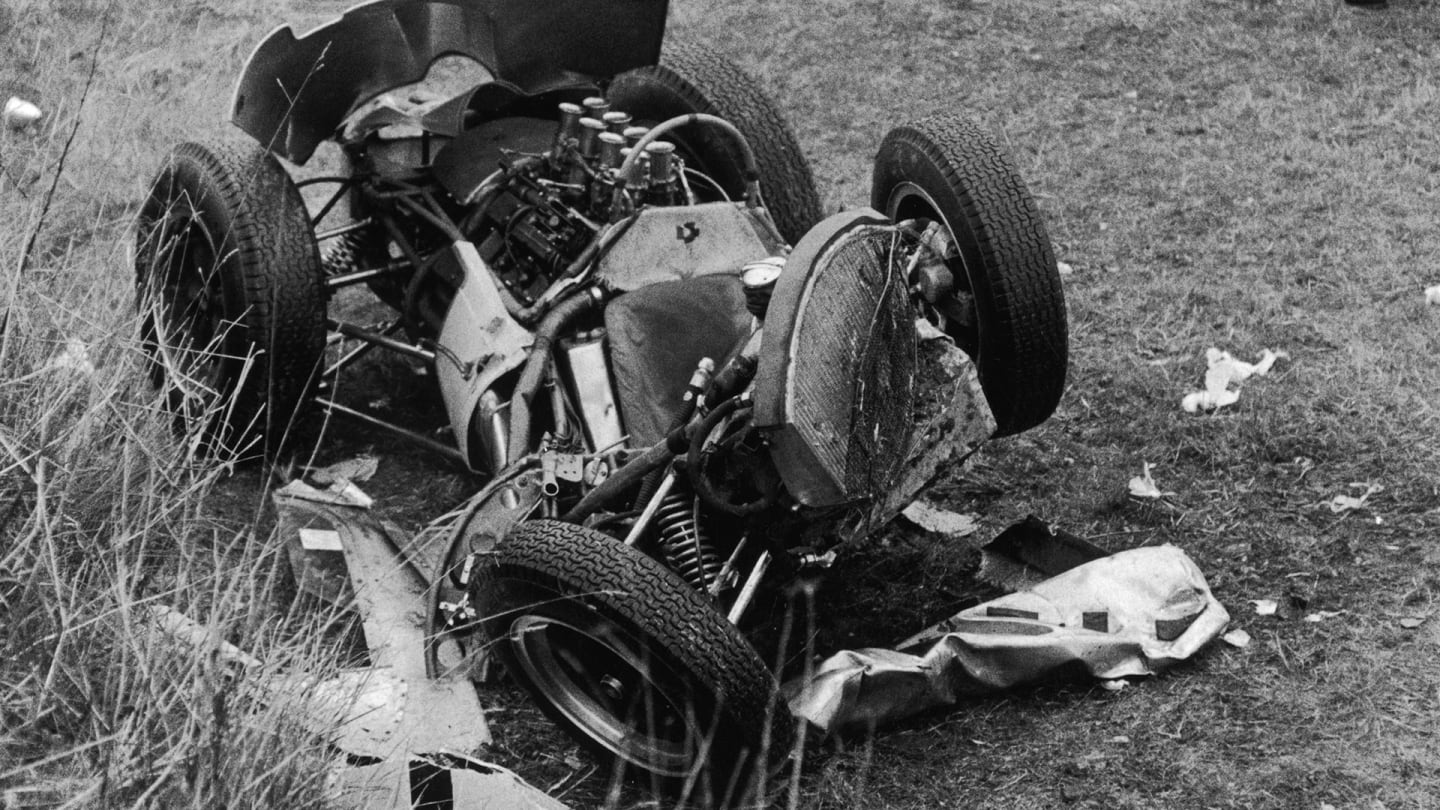
The aftermath of Moss's big shunt at Goodwood in 1962. He survived - but would never race at the highest level again. (Photo by Victor Blackman/Express/Getty Images)
With a Prof Watkins to advise him, who knows where his career might finally have ended, had he been fit enough to return fulltime by 1964, when he would only have been 34, coming up for 35?
In the end, though, not winning the title was as helpful to him in later life as if he had won the five or more that he deserved.
“You see, I've been very lucky in my life,” he would say. “I've never won a World Championship, and it would now, I think, be detrimental to have won one. I'm better off never having won one. It does put people in difficult positions writing books on World Champions if they want to mention myself, but then it doesn't matter. On the overall picture I'm better off with none. I'm the man that people say, 'Gosh, he should have won.'
“I think I had a fair innings, really. It's now years since I drove a car, and yet I'm still selling my name. Which is good, because I do an awful lot of things. And I do talks and things, for which I'm paid. And I have to be. That's how I make my living, selling my time and my name. And I think a lot of that is because a) I have made myself accessible, and b) always had something to say if people ring me up and ask what do I think of something. It doesn't matter what it is, I have opinions. They may not be right ones, but at least I have them and I'm not frightened of saying them."

Moss with wife Lady Susie in 2015. It was only in recent years he retired from public life (Photo by David M. Benett/Dave Benett/Getty Images)
In his heyday, he loved nothing more than going into a corner and looking in his mirror and seeing another driver behind, and then seeing that same driver three or four feet further back when he looked again as he exited the corner. “That's when I felt six feet tall. You know, beat that! It's a very lonely place, leading a race on your own, not dicing, no two ways about it. But even when you're on your own, you're still dicing. You come out of a corner and look down and maybe you'll see 6700 revs. And the next lap you try that little bit harder, just to try and see a little bit more. You're dicing with yourself. And you are your own toughest critic."
Stirling Moss was one of the greatest of them all. And as he leaves us we are left with our indelible memories and images of a uniquely talented and charismatic man. One whose behaviour on and off the race track will forever bear witness that you don't have to wear a crown to be a champion.
When Lewis Hamilton met Sir Stirling Moss
Share
YOU MIGHT ALSO LIKE
News Victor Martins to make F1 weekend debut as Williams confirm F2 racer for FP1 in Barcelona
News Bortoleto unhappy with ‘risk’ Antonelli took that resulted in crash after ‘embarrassing’ overtake
News How to stream the Formula 1 2025 Spanish Grand Prix on F1 TV Premium
News ‘Painful’ – Gasly laments ‘quite sad’ Monaco GP crash as Colapinto reflects on ‘tricky’ weekend for Alpine
